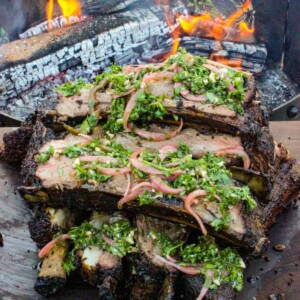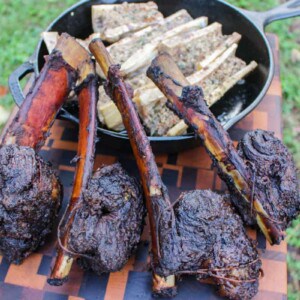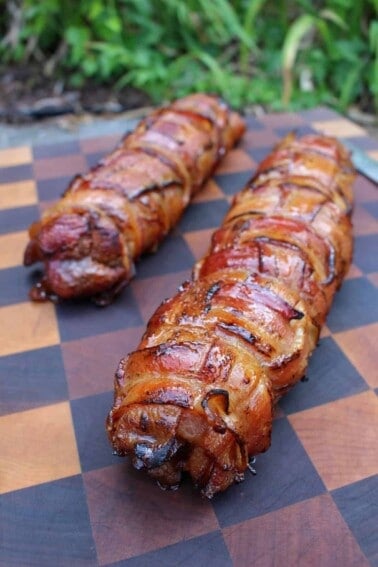Everyone say it with me: RIBS! That’s always how I feel when I know they’re for dinner — all caps, freakin’ stoked.. Tender ribs are so delicious, and there’s really nothing like them. It always feels like a party when a rack of ribs are on the menu.

I know cooking the barbecue ribs can be intimidating if you’re not sure of the best way to go about it, which is what I’m here for. I’ve got a roundup of my favorite recipes, along with all the tips and tricks you’ll need to make the best ones out there.
Why You’ll Love Ribs
Bone tender, juicy, flavorful, enough to scale up and feed a crowd — what’s not to love? They’re so freakin’ delicious with your favorite dry rub and homemade BBQ sauce. Just keep in mind that while the process of cooking is very easy, it does take a long time. It’s all just about heat management.

For more of my favorite saucy BBQ recipes, check out Honey Fire BBQ Wings, Pulled Pork BBQ Sandwich, Honey Bacon BBQ Chicken Lollipops and Western BBQ Burger.
How to Cook the Best Ribs
Prep Basics
Choosing Your Cut
You’ll hear the most about three types of ribs: baby back ribs, St. Louis style ribs and spare ribs.
Baby backs are incredibly popular, and for good reason. They usually have more meat on the top of the ribs than on the sides of the ribs. The bones are more curved and they come from the upper part of the pig’s back.

St. Louis style ribs and spare ribs are actually two names for the same cut. They have more meat between the bones and fat and come from the belly of the pig. The meat on St. Louis style ribs isn’t always as tender as baby back ribs, but the flavor is awesome.
Which one you’ll choose depends on the recipe, but I truly believe you can’t go wrong.
Trimming
The first thing you’ll want to do is trim the excess fat so you don’t have any flare-ups on the grill. A rack also has a silver skin on the back of the ribs, so you’ll need to remove this thin membrane before cooking.
First, flip your ribs so the bones are curled toward you. Then, use your fingers or a paring knife to slide under the membrane and lift it to remove that first piece from the bones. Finally, grab a paper towel and pull slowly but firmly across until you’ve removed the whole thing.

Some recipes may also have you cut the rack into individual ribs to cook them, so just double-check before you get started. You’ll want a sturdy cutting board and sharp knife for that job.
Seasoning
I find it best to slather them with mustard and use a spice rub before you put them in the smoker. You can also use a mop sauce or your favorite barbecue sauce while you’re cooking to keep them most, then get that delicious caramelization at the end.

Add flavor to everything you’re cooking
shop over the fire spice lines

Cooking & Smoking
There are a couple ways I like to do this. If I’m cooking a full rack, I use indirect heat at a low temperature for slow cooking and cook the ribs for several hours. That mop sauce or your favorite BBQ sauce every 30-45 minutes keeps them tender.

If I’m cooking individual ribs, a crutch is foolproof way to get tender, flavorful ribs. A crutch involves wrapping the meat in aluminum foil to concentrate the heat, reduce evaporation and speed up the cooking process.
I usually put the meat in a foil pan. Then, you can add all sorts of delicious ingredients — soy sauce, butter, beer and even whisky. I cover the whole pan tightly with a foil lid and get fall-of-the-bone ribs in no time.

Finishing and Serving
For the indirect cooking method, the racks will finish on their own since they’re already directly on the smoker. Make sure you let them rest for about 15 minutes after you take them off the grill so we can lock in those flavors and juices!

When I’m cooking in the crutch, once the meat is up to temp, I’ll put them back directly on the hot grill for another 20-30 minutes to get those deep flavors and caramelization. Then, it’s all about serving and enjoying these freakin’ delicious ribs.
My Favorite Rib Recipes
Now that we’ve gone through the process to make the best ribs, here’s the roundup of my favorite recipes! Be sure to let me know in the comments which ones you tried and liked the best!
Pork Ribs


Smoked Party Ribs

Honey Fire Party Ribs

Habañero Peach Smoked Ribs

Smoked Ribs with Bourbon Mop Sauce

Nashville Hot Smoke Fried Ribs


Peanut Butter and Jelly Sticky Ribs

Huli Huli Ribs with Sriracha BBQ Sauce

Crown Rack of Ribs

Maple Gochujang Rotisserie Ribs

Sweet Teriyaki Sake Smoked Ribs

Jalapeño Watermelon BBQ Ribs

Maple Cajun Smoked Ribs

Teriyaki Ribs

Maple Guinness BBQ Pork Ribs

Molasses Espresso St. Louis Style Pork Spareribs

Spicy BBQ Ribs

Beef Ribs

Rotisserie Beef Ribs

Smoked Garlic Jalapeño Beef Ribs


Smoked Wagyu Beef Back Ribs

Chipotle Black Pepper Smoked Beef Ribs
Smoked Jack Daniels Beef Ribs

Braised Beef Short Ribs

Grilled Beef Short Ribs


Rotisserie Smoked Short Ribs

Grilled Korean BBQ Short Ribs
Lamb Ribs

Honey Chipotle BBQ Lamb Ribs

What to Serve with Ribs
Ribs are such a classic BBQ meal that it makes sense to keep it classic with the sides. The jalapeno cheddar cornbread highlighted in this recipe is so freakin’ delicious, and you can do a green salad, broccoli slaw or coleslaw as a vegetable.
For More Smoked Pork
Leftovers and Reheating
For leftovers, wrap them in foil or an airtight container and store in the fridge for 3-5 days. A low, slow oven is the best way to reheat these juicy ribs so they don’t dry out. Place the meat on a baking sheet, cover tightly with heavy-duty aluminum foil and reheat at 200-205 degrees.
FAQs
Ribs have a lot of fat and connective tissue, which means they need more time to break down and redistribute the fat and flavor. You also want to cook them at low temperatures, around 200-250 degree F, so that process can happen properly.
Anything with brown sugar, kosher salt, black pepper, onion powder, garlic powder and smoked paprika is so freakin’ delicious. You can also make your own or check out my rubs and blends on Spiceology!
They’re really different! Beef ribs are larger and have more fat, so they tend to be better when you braise them. Pork has a milder flavor, so they can be more versatile. But my favorite is whichever one is on my plate, they’re both great and full of flavor.

Get The Cookbooks!
Flavor X Fire & FOOD X Fire
All the major tastes—salty, sour, sweet, bitter, and umami—are explored in depth, along with an investigation of other components you should consider when it comes to flavor, such as aroma, heat, and texture.

















